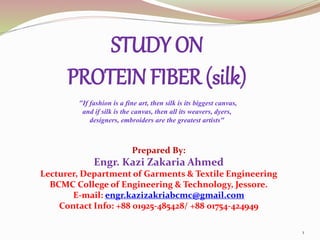
SILK
- 1. STUDY ON PROTEIN FIBER (silk) "If fashion is a fine art, then silk is its biggest canvas, and if silk is the canvas, then all its weavers, dyers, designers, embroiders are the greatest artists" 1 Prepared By: Engr. Kazi Zakaria Ahmed Lecturer, Department of Garments & Textile Engineering BCMC College of Engineering & Technology, Jessore. E-mail: engr.kazizakriabcmc@gmail.com Contact Info: +88 01925-485428/ +88 01754-424949
- 2. LECTURE-2 6:38:27 AM 2 Prepared For: B.Sc. In Textile Engineering Students of Garments & Textile Engineering Department
- 3. Thursday, November 17, 2016 3 SILK Silk is a fibroin made of proteins secreted in the fluid state as single filament by a caterpillar, popularly known as 'silkworm'. Silk is a natural protein fiber. Cultivation of cocoons for the filament. Silk filament are 600-1700 m. long. Diameter range from 12-30 micrometer. Fiber length to breadth ratio is 2000:1 It is off-white to yellow in color.
- 4. Thursday, November 17, 2016 4
- 5. Thursday, November 17, 2016 5 There are four types of natural silk which are commercially known and produced in the world. Among them mulberry silk is the most important and contributes as much as 90 per cent of world production, therefore, the term "silk" in general refers to the silk of the mulberry silkworm. Three other commercially important types fall into the category of non-mulberry silks namely: Eri silk; Tasar silk; and Muga silk. There are also other types of non-mulberry silk, which are mostly wild and exploited in Africa and Asia, are Anaphe silk, Fagara silk, Coan silk, Mussel silk and Spider silk.
- 6. Silk Chemical Structure Thursday, November 17, 2016 6
- 7. PHYSICAL STRUCTURE OF SILK Thursday, November 17, 2016 7
- 8. FIBROIN 75% ASH OF SILK FIBROIN 0.5% SERICIN 22.5 % FAT & WAX 1.5% MINERAL SALT 0.5% Thursday, November 17, 2016 8 COMPOSITION OF SILK
- 9. PHYSICAL PROPERTIES OF SILK Thursday, November 17, 2016 9
- 10. PROPERTIES Thursday, November 17, 2016 10
- 11. CHEMICAL PROPERTIES OF SILK Thursday, November 17, 2016 11 Effect of Acid: Concentrated mineral acids will dissolve silk faster than wool. Organic acids do not harm silk. Effect of Alkalies: Silk is not as sensitive as wool is to alkalies, but it can be damaged if the concentration and the temperature are high enough. Us e mild soap or detergent in lukewarm water whe laundering. Effect of Bleaches: Strong bleaches containing sodium hypochlorite will deteriorate silk.Hydrogen Peroxide or sodium perborate may be used. Effect of Light: Continuous exposure to light weakens silk faster than either cotton or wool. Raw silk is more resistant to light than digammed silk. Resistance to Mildew: Silk may not mildew unless left for some time in a damp state or under the extreme conditions of tropical dampness . Affinity of dyes: Silk has a very good affinity to dyes. It readily absorbs acid, basic and direct dyes. Resistance to Insects: Silk may be attacked by the larvae of cloths moths or carpet beetles and it may be destroyed when blended with wool which is attacked by these insects.
- 12. Thursday, November 17, 2016 12
- 13. FIBROIN SERICIN Thursday, November 17, 2016 1. Elastic protein forming the core of silk filament. Secreted from the posterior part of silk gland. Not soluble in water. Pigments are absent. Gelatinous protein forms the outer coat of silk filament. Secreted from the middle part of silk gland. Soluble in water. May contain pigments. 13 DIFFERENCES
- 14. The major silk producing countries in the world are; China, India, Uzbekistan, Brazil, Japan, Republic of Korea, Thailand, Vietnam, DPR Korea, Iran, etc. Few other countries are also engaged in the production of cocoons and raw silk in negligible quantities; Kenya, Botswana, Nigeria, Zambia, Zimbabwe, Bangladesh, Colombia, Egypt, Japan, Nepal, Bulgaria, Turkey, Uganda, Malaysia, Romania, Bolivia, etc. Thursday, November 17, 2016 14
- 15. The major silk consumers of the world are; USA, Italy, Japan, India, France, China, United Kingdom, Switzerland, Germany, UAE, Korea, Viet Nam, etc. Thursday, November 17, 2016 15
- 16. Thursday, November 17, 2016 16
- 17. Thursday, November 17, 2016 17
- 18. Thursday, November 17, 2016 18
- 19. Thursday, November 17, 2016 19